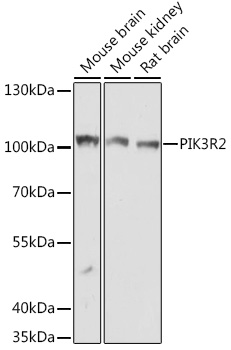Cell Biology Antibodies 13
Anti-PIK3R2 Antibody (CAB17518)
- SKU:
- CAB17518
- Product Type:
- Antibody
- Reactivity:
- Human
- Reactivity:
- Mouse
- Reactivity:
- Rat
- Host Species:
- Rabbit
- Isotype:
- IgG
- Antibody Type:
- Polyclonal Antibody
- Research Area:
- Cell Biology
Description
| Antibody Name: | Anti-PIK3R2 Antibody |
| Antibody SKU: | CAB17518 |
| Antibody Size: | 20uL, 50uL, 100uL |
| Application: | WB IHC |
| Reactivity: | Human, Mouse, Rat |
| Host Species: | Rabbit |
| Immunogen: | Recombinant fusion protein of Human PIK3R2. |
| Application: | WB IHC |
| Recommended Dilution: | WB 1:500 - 1:2000 IHC 1:50 - 1:100 |
| Reactivity: | Human, Mouse, Rat |
| Positive Samples: | Mouse brain, Mouse kidney, Rat brain |
| Immunogen: | Recombinant fusion protein of Human PIK3R2. |
| Purification Method: | Affinity purification |
| Storage Buffer: | Store at -20°C. Avoid freeze / thaw cycles. Buffer: PBS with 0.02% sodium azide, 50% glycerol, pH7.3. |
| Isotype: | IgG |
| Sequence: | Email for sequence |
| Gene ID: | 5296 |
| Uniprot: | O00459 |
| Cellular Location: | |
| Calculated MW: | 81kDa |
| Observed MW: | 100kDa |
| Synonyms: | MPPH, MPPH1, P85B, p85, p85-BETA, PIK3R2 |
| Background: | Phosphatidylinositol 3-kinase (PI3K) is a lipid kinase that phosphorylates phosphatidylinositol and similar compounds, creating second messengers important in growth signaling pathways. PI3K functions as a heterodimer of a regulatory and a catalytic subunit. The protein encoded by this gene is a regulatory component of PI3K. Two transcript variants, one protein coding and the other non-protein coding, have been found for this gene. [provided by RefSeq, Dec 2012] |
| UniProt Protein Function: | PIK3R2: regulatory subunit of phosphoinositide-3-kinase. Mediates binding to a subset of tyrosine-phosphorylated proteins through its SH2 domain. Acts as an adapter, mediating the association of the p110 catalytic unit of the alpha, beta and delta enzymes to the plasma membrane, where p110 phosphorylates inositol lipids. May play an additional role in the regulation of the actin cytoskeleton. Necessary for the insulin-stimulated increase in glucose uptake and glycogen synthesis in insulin-sensitive tissues. Its SH2 domains interacts with the YTHM motif of phosphorylated INSR in vitro. Defects in PIK3R1 are a cause of severe insulin resistance. Four alternatively spliced isoforms have been described. |
| UniProt Protein Details: | Protein type:Kinase, lipid; Motility/polarity/chemotaxis Chromosomal Location of Human Ortholog: 19q13.2-q13.4 Cellular Component: cytosol; nucleus; phosphoinositide 3-kinase complex Molecular Function:1-phosphatidylinositol-3-kinase activity; 1-phosphatidylinositol-3-kinase regulator activity; protein binding; protein heterodimerization activity; protein phosphatase binding; receptor tyrosine kinase binding Biological Process: blood coagulation; cell glucose homeostasis; cellular response to insulin stimulus; epidermal growth factor receptor signaling pathway; fibroblast growth factor receptor signaling pathway; innate immune response; insulin receptor signaling pathway; leukocyte migration; nerve growth factor receptor signaling pathway; phosphatidylinositol biosynthetic process; phosphoinositide 3-kinase cascade; phosphoinositide phosphorylation; phosphoinositide-mediated signaling; phospholipid metabolic process; positive regulation of transcription factor import into nucleus; positive regulation of transcription from RNA polymerase II promoter; protein transport; regulation of autophagy; regulation of phosphoinositide 3-kinase activity; regulation of small GTPase mediated signal transduction; small GTPase mediated signal transduction; T cell receptor signaling pathway; vascular endothelial growth factor receptor signaling pathway Disease: Megalencephaly-polymicrogyria-polydactyly-hydrocephalus Syndrome 1 |
| NCBI Summary: | Phosphatidylinositol 3-kinase (PI3K) is a lipid kinase that phosphorylates phosphatidylinositol and similar compounds, creating second messengers important in growth signaling pathways. PI3K functions as a heterodimer of a regulatory and a catalytic subunit. The protein encoded by this gene is a regulatory component of PI3K. Two transcript variants, one protein coding and the other non-protein coding, have been found for this gene. [provided by RefSeq, Dec 2012] |
| UniProt Code: | O00459 |
| NCBI GenInfo Identifier: | 317373311 |
| NCBI Gene ID: | 5296 |
| NCBI Accession: | O00459.2 |
| UniProt Secondary Accession: | O00459,Q5EAT5, Q9UPH9, |
| UniProt Related Accession: | O00459 |
| Molecular Weight: | 81,545 Da |
| NCBI Full Name: | Phosphatidylinositol 3-kinase regulatory subunit beta |
| NCBI Synonym Full Names: | phosphoinositide-3-kinase regulatory subunit 2 |
| NCBI Official Symbol: | PIK3R2 |
| NCBI Official Synonym Symbols: | p85; MPPH; P85B; MPPH1; p85-BETA |
| NCBI Protein Information: | phosphatidylinositol 3-kinase regulatory subunit beta |
| UniProt Protein Name: | Phosphatidylinositol 3-kinase regulatory subunit beta |
| UniProt Synonym Protein Names: | Phosphatidylinositol 3-kinase 85 kDa regulatory subunit beta; PI3-kinase subunit p85-beta; PtdIns-3-kinase regulatory subunit p85-beta |
| Protein Family: | Phosphatidylinositol 3-kinase regulatory |
| UniProt Gene Name: | PIK3R2 |
| UniProt Entry Name: | P85B_HUMAN |







